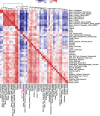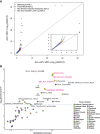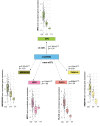Cell-type-specific eQTL of primary melanocytes facilitates identification of melanoma susceptibility genes
- PMID: 30333196
- PMCID: PMC6211648
- DOI: 10.1101/gr.233304.117
Cell-type-specific eQTL of primary melanocytes facilitates identification of melanoma susceptibility genes
Abstract
Most expression quantitative trait locus (eQTL) studies to date have been performed in heterogeneous tissues as opposed to specific cell types. To better understand the cell-type-specific regulatory landscape of human melanocytes, which give rise to melanoma but account for <5% of typical human skin biopsies, we performed an eQTL analysis in primary melanocyte cultures from 106 newborn males. We identified 597,335 cis-eQTL SNPs prior to linkage disequilibrium (LD) pruning and 4997 eGenes (FDR < 0.05). Melanocyte eQTLs differed considerably from those identified in the 44 GTEx tissue types, including skin. Over a third of melanocyte eGenes, including key genes in melanin synthesis pathways, were unique to melanocytes compared to those of GTEx skin tissues or TCGA melanomas. The melanocyte data set also identified trans-eQTLs, including those connecting a pigmentation-associated functional SNP with four genes, likely through cis-regulation of IRF4 Melanocyte eQTLs are enriched in cis-regulatory signatures found in melanocytes as well as in melanoma-associated variants identified through genome-wide association studies. Melanocyte eQTLs also colocalized with melanoma GWAS variants in five known loci. Finally, a transcriptome-wide association study using melanocyte eQTLs uncovered four novel susceptibility loci, where imputed expression levels of five genes (ZFP90, HEBP1, MSC, CBWD1, and RP11-383H13.1) were associated with melanoma at genome-wide significant P-values. Our data highlight the utility of lineage-specific eQTL resources for annotating GWAS findings, and present a robust database for genomic research of melanoma risk and melanocyte biology.
© 2018 Zhang et al.; Published by Cold Spring Harbor Laboratory Press.
Figures





References
Publication types
MeSH terms
Substances
Grants and funding
- P50 CA097007/CA/NCI NIH HHS/United States
- C8216/A6129/CRUK_/Cancer Research UK/United Kingdom
- C588/A4994 /CRUK_/Cancer Research UK/United Kingdom
- 19167/CRUK_/Cancer Research UK/United Kingdom
- C588/A10589/CRUK_/Cancer Research UK/United Kingdom
- MR/L01629X/1/MRC_/Medical Research Council/United Kingdom
- C1287/A10118 /CRUK_/Cancer Research UK/United Kingdom
- R01 CA133996/CA/NCI NIH HHS/United States
- R01 CA083115/CA/NCI NIH HHS/United States
- C588/A19167 /CRUK_/Cancer Research UK/United Kingdom
- C490/A10124 /CRUK_/Cancer Research UK/United Kingdom
- R01 ES011740/ES/NIEHS NIH HHS/United States
- P50 CA093459/CA/NCI NIH HHS/United States
- 10589/CRUK_/Cancer Research UK/United Kingdom
LinkOut - more resources
Full Text Sources
Medical
Molecular Biology Databases
Research Materials
Miscellaneous
